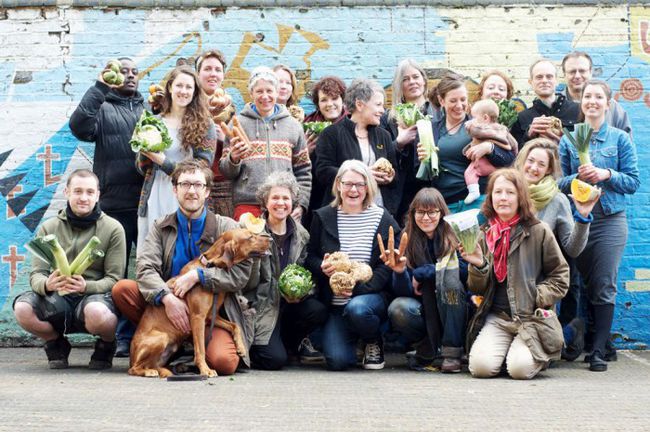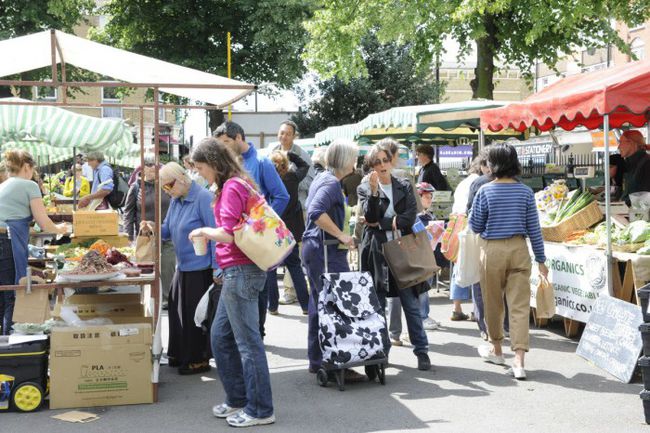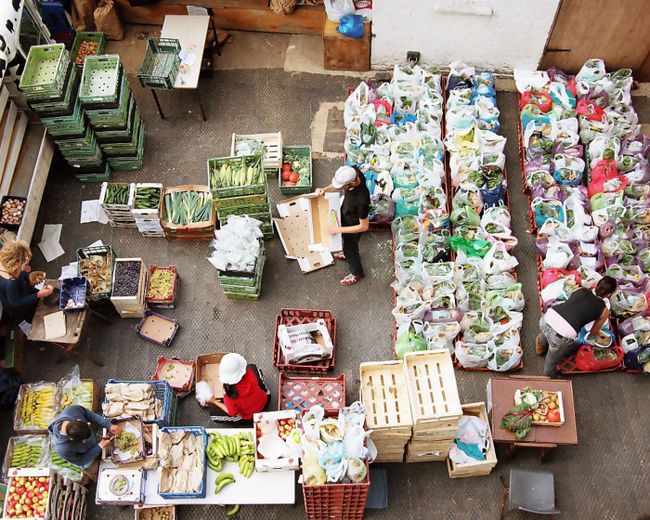27 Oct 2015
Julie Brown on food and fairness
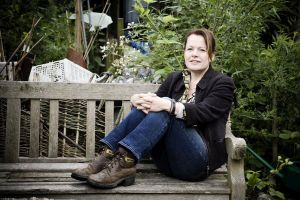
In our final post on our theme of fairness, we talk to Julie Brown. Julie is Director of Growing Communities, a social enterprise based in Hackney in North East London. They run a box scheme which supplies vegetables to about 1000 households in Hackney and run the weekly Stoke Newington Farmers’ Market. They also do urban food growing on what we call a ‘Patchwork Farm’ on small sites in Hackney and a larger site in Dagenham. The other thing they do is run a startup programme, working with other communities to help them set up similar projects. We started by asking Julie what, for her, does a fair food system look like? What are its elements, its criteria?
“It is quite hard to separate the concept of a fair system from a sustainable one, so I’m going to muddle them together. In overall terms, what a fair system would do is to pay farmers who are farming in a sustainable way, it would pay them a fair price so that they could actually survive and thrive.
In big terms, that’s probably one of the fundamental unfairnesses about the food system as it currently is. The farmers that are attempting to do the right thing for the planet and for diets and for other elements that we want to have fantastic food, these are the ones that find it almost impossible to make a living and survive in the current system. There’s some sort of really fundamental unfairness there. That’s probably where I would start.
A fair food system would also produce food that is good for people, and affordable, and accessible to everyone. It would be fair to workers. It would pay people in retail outlets and agricultural workers as well as people running businesses a fair price, and it would be fair to communities, so communities would have a say in how things are run, they would be connected to the farming and the people that are producing their food, and the businesses that were running in their communities wouldn’t be extracting value from those communities.
They’d be investing back into those communities, and it would be fair to the planet, so it wouldn’t be degrading soil, reducing biodiversity and causing climate chaos.
Why, for you, does bringing food closer to home make it fairer? A big focus of your work is around reconnecting food production to place…
There’s a number of different elements to that as well. There’s the food miles type element of it but that’s only a very minor part of it really. It’s the fact that food that is produced closer to where it’s eaten tends to be fresher and involve less resource problems in terms of its transportation and production.
But it’s also about transparency and connection. I think you care and are able to relate better to things when you know where they’ve come from, and you know who has grown them. That relationship is going to be more fair and more respectful because it’s more transparent and it’s clearer. You can’t guarantee that obviously, but that’s what tends to come out of that.
So again, if I relate it to very practically how we work, we care about our farmers. We know who they are. We want to them to do well. We want them to be able to run their business and carry on producing the fantastic food that they do. And we want to be able to provide it to the people that come to the market and who buy food through the box scheme at a fair price. So if we look at the elements that are linked more directly to money, what we try to do through our projects again is make sure we start with the price that we pay the farmer, that we pay them the price that they need to farm sustainably. That’s the thing that is currently going in entirely the opposite direction to that at the moment in terms of the way the food system is heading now
Maximising productivity is defined by getting maximum yield for the least amount of money, or involving the least amount of labour. All the other external costs of the food system: the soil degradation; the climate impact; the impact on wildlife; none of those are costed in. The way we define what is “good” about farming systems works entirely against producing food in a sustainable and fair way. Farmers who are attempting to not work in that way are being driven out of business by that world view. That direction of travel, essentially.
What we’re trying to do at Growing Communities is trying to reach out directly as communities to those farmers and saying “we’ll buy your food at a fair price”. So we start with that. Then we try and work out how we’re going to pay people in Hackney through the box scheme and the farmers’ markets so that they can actually work on those projects.
We have a commitment to paying people the London Living Wage, and we have a 2 to 1 pay structure, so nobody is paid more than twice the lowest paid worker in our organisation. Then we are looking at how we can sell the food to our customers at the most affordable price. That’s the sort of equation that we’re working with, that’s the financial equation we’re working with.
But we start with that basic, fundamental principle that we have to pay the price that’s required to have food produced in a way that doesn’t have all of these negative impacts and actually brings amazingly positive impacts. Through that, reconnecting with the farmers and also creating enterprises locally, we can create community, which is another thing in our name which is a bit of a hint. So we can create community, we can create jobs and the third element is in terms of our organisational structure, which again is what’s not fair about the current food system.
We say we are “driven by principles, not by profit”, so we’re a not-for-profit. We want to cover our costs and we want to make a surplus, but we want to reinvest that back into our projects and into our community. It’s about investing in community, not extracting from community.
We talked before we started about this Eco Modernist thing that was recently launched (Eco Modernist statement here, and George Monbiot’s brilliant demolition of it here). They would argue that surely the bigger and bigger scale you produce food on then actually you can put more land just down to wild systems and you can produce food cheaper and so you have more biodiversity and cheaper food, and isn’t that a fairer system?
Er, no. That’s the short answer.
The long answer? There are so many 1+1=5 sort of issues going on in that. We have to, I believe, accept that there are limits. There are biological and natural limits to what we need to be doing on the planet to live sustainably. Now I’d argue, to go back to those Eco Modernists, I don’t think they’ve quite accepted that, that there are limits.
I’m really happy to be applying science and technology and creativity to the issues around food and farming and, in fact, of everything. But we need to do that within a framework that accepts that there are natural limits. There are climate limits, there are soil limits, there are water limits. People are going to argue about yields, it comes back to this yields/productivity discussion again.
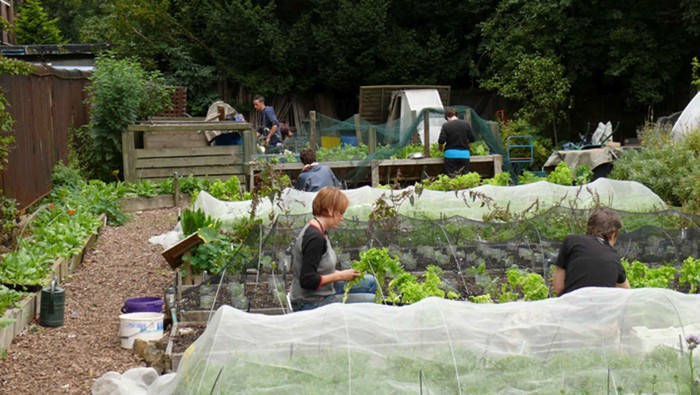
But if we looked at the food and farming system through a different productivity lens, one that looked at labour actually as a positive output of the system, not a cost, and actually properly costed the energy resources and the other resources that were required to produce food, then the smaller-scale systems would actually look much more favourable. I’m not going to say they’re going to blow the other ones out of the water, but I think in some cases they would.
We think the foundations of a sustainable and fair food and farming system are small to medium scale enterprises. We’re not talking about one size fits all either. I talk about it in terms of ‘food subsidiarity’. We’re talking about an appropriate scale and multi-scaled operations depending on the food that’s being produced and whether it’s mainly arable or livestock or horticulture, although there is a real value in all those types of systems getting more mixed.
We would support a mixed farming system. We also need to look at the supply side as well as what diets are like and what people are expecting to eat. It’s hugely complex, in terms of livestock production and how much food people should be eating of different types. Our latest Food Zones map looks at the kind of farming systems we think are the basis of it, essentially multi-scale but mixed farming systems – low input, pretty much organic, and utilising human skills and labour, and it’s backed up by science and technology and machinery, but it’s grounded by sound science.
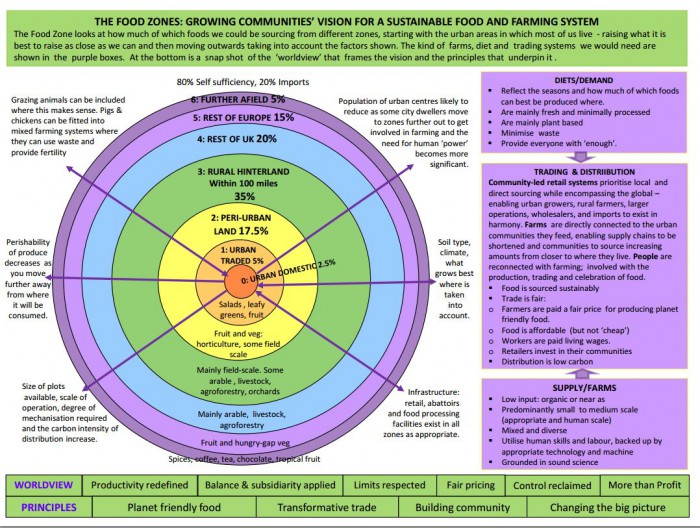
That sound science is about observing and seeing what’s going on in quite a complex system, which farming is, but we’ve got to look at the demand side as well, which is that we need to be eating a mainly plant-based diet, and mainly fresh food, reducing the amount of processed food, minimising waste. All of those things are going to produce a diet that is really pretty good for you. But we need to pay farmers to farm in that way.
You mentioned your Food Zones map. I sometimes show that in talks and people find it really fascinating in terms of the degree to which you’ve thought through the implications and the practicalities of London sitting in the middle of that kind of a food web. I wonder if you could just give us a sense of where that came from and what you think its key implications are?
It has come from many years of working in this area, pulling all the different elements together into what is essentially a vision of how we would like to see the food and farming system operating. It’s also totally based on the very pragmatic way that we work. The percentages are roughly based on what we managed to do through our box scheme.
Our box scheme is trading just fruit and veg, so in terms of the wider food system, some of that is still to be proven. But actually I’m working on a project at the moment which is going to attempt to model this and see what diet would be produced if we actually did operate like this. The way that I’d like to do it again is through a very practical approach, which is to find the best example which is currently in each of the zones and then to multiply it up into the zone in terms of the amount of land that’s in theory available, and then what sort of food and the quantities it would produce.
But then I’ll have to change the percentages because that’s what you do anyway. It’s based on an intuitive knowledge of all the different factors, throwing them all around together into this thing. I would eventually like to prove it, but I think we’ll prove it by doing it. We are actually doing it, because when this Food Zones was first produced, there were little, tiny pockets of things going on and now there’s masses of stuff going on. Lots of new people are getting into farming and actually into retailing and into CSA schemes, urban production and lots of amazing new activity going on, which it would be great to track it and show it more clearly, but also show what the impacts of it are more clearly, and show that it actually is starting to create a real alternative to the mainstream food system at the moment.
When I show it in talks, I sometimes say that to me it’s like a map of the new economy. If I was 18 now, and looking at that, I’d be thinking – I want to train to become a really good market gardener, a craft brewer or a mushroom grower or something. It presents so many options and possibilities to people, that’s what I love about it.
Thank you. I noticed a talk when you said that. We need to prove it now! We need to prove it by doing it as well. That’s the thing, Growing Communities’ approach has always been about an empirical and theoretical approach. There’s this overall vision and we very practically just go out and create stuff that’s actually going to be real.
